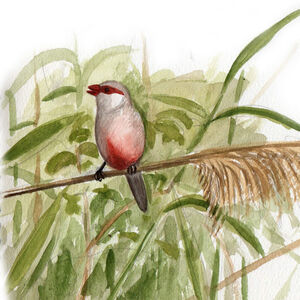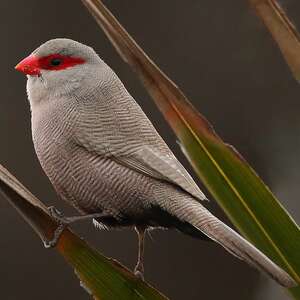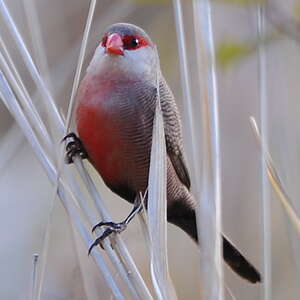Common Waxbill
Estrilda astrild - Astrild ondulé
Identification
The Common Waxbill is a small bird measuring 13cm, placed size wise between the Blue Tit and the Coal Tit. Its most striking visual characteristic is its red, arrow-shaped mask that stretches from its beak all the way to its ear-coverts. This bright colour is further accentuated by its large and bright red conical beak. Its brown eyes are nicely contrasted with the red mask. The dominant colour of the bird is gray-brown, with some regional variations. Its crest and neck are grey, more or less streaked, its cheeks and throat ranges from white to grey; the red mask separates both parts of the head. The rest of the body is finely but clearly streaked. Its back and sides of the neck are grey and yet to have streaks. The mantle, the wings (short and rounded), the rump and the tail are brown-gray, its primary remiges and rectrices are slightly darker and more brown. Their streaks are also wider. The streaks of the upper parts are repeated in the lower part of the chest and flanks which are lighter beige. A more or less red or pink patch is visible in the middle of the belly. Again, its size varies according to different areas, and can reach up to the throat. The undersides of the tail and the belly are black. The second part of the rectrices is black and the streaks are almost invisible. The female's undersides of the tail are brownish. The legs are black. The juvenile has a duller plumage and a black beak with a white rim on its commissures. The immature has a pink beak.
Subspecific information 15 subspecies
- Estrilda astrild astrild (s Botswana and w and s South Africa)
- Estrilda astrild kempi (Guinea, Sierra Leone and Liberia)
- Estrilda astrild occidentalis (s Mali and Ivory Coast to n DRCongo, Bioko I.)
- Estrilda astrild peasei (Ethiopia)
- Estrilda astrild macmillani (Sudan)
- Estrilda astrild adesma (e DRCongo, Uganda, w Kenya to nw Tanzania)
- Estrilda astrild massaica (c Kenya to n Tanzania)
- Estrilda astrild minor (s Somalia, e Kenya, ne Tanzania and Zanzibar)
- Estrilda astrild cavendishi (s DRCongo and s Tanzania to Zimbabwe and Mozambique)
- Estrilda astrild niediecki (c Angola to w Zimbabwe)
- Estrilda astrild angolensis (inland w Angola)
- Estrilda astrild jagoensis (coastal w Angola, São Tomé)
- Estrilda astrild rubriventris (Gabon to nw Angola)
- Estrilda astrild damarensis (Namibia)
- Estrilda astrild tenebridorsa (n and e South Africa)
Foreign names
- Astrild ondulé,
- Estrilda común,
- bico-de-lacre-comum,
- Wellenastrild,
- asztrild,
- Sint-Helenafazantje,
- Astrilde di Sant'Elena,
- helenaastrild,
- Vatreastrild,
- astrilda vlnkovaná,
- astrild vlnkovaný,
- Helena-astrild,
- vahanokka,
- Rooibeksysie (Rooibekkie),
- bec de corall senegalès,
- Fagurstrildi,
- astryld falisty,
- viļņainais vasknibis,
- rečna astrilda,
- Волнистый астрильд,
- オナガカエデチョウ,
- 梅花雀,
- helenaastrild,
- 橫斑梅花雀,
Habitat
Behaviour character trait
The Common Waxbill is a gregarious and monogamous bird. They move in more or less dispersed but noisy groups and individuals meet up at night in dormitories.
Very numerous in their habitats, they have a destructive impact in areas where they have been introduced. Paradoxically, this impact is lesser in their original territories. Yet, they likely have an important role in seed dispersion. Finally, they seem to have no impact on indigenous granivorous birds, since they feed mostly on introduced grasses. They feed in the early morning and late afternoon. They cling to the stems with their long claws and peck at flower heads. They also seek out the seeds on the ground. Predominantly granivorous, water sources are of huge importance to them. The bird groups also mingle among herds of ruminants, where they can be in the thousands. Very social, the Common Waxbill uses singing and body language to communicate with its fellow species.Dietfeeding habits
Reproduction nesting
The Common Waxbill breeds during the rainy season when insects are more numerous, though this varies according to the region of the world.
At this season, each couple separates from their usual flock, and nests can sometimes be found quite close together. The courtship begins with a bow and a gift exchange. To impress his female, the male ruffles his feathers and points his beak upwards so his red belly is as visible as possible. Throughout the nest construction, the pair preen each other's feathers to strengthen their bond and perform lateral movements with their tail. The nest is a large ball of intertwined grasses with a downward-facing, tunnel-shaped entrance which leads to a chamber. It is reminiscent of a Southern Masked Weaver's nest, but much rounder. It is placed very low down amongst dense vegetation. To counteract potential predation from rodents or snakes due to the nest's position, it is often built close to carnivore mammal droppings. Serval droppings are most commonly used. The smell discourages predators as well as camouflaging the scent of the eggs. A second, very basic nest can also be built slightly higher up for the male. The pair's nest can be parasitized by the Baya Weaver. The female lays 4 to 7 eggs, which are incubated by both sexes. Incubation lasts 11 to 13 days. The young leave the nest between 17 and 21 days and are fed by both parents for a few days after fledging. Several clutches may occur in one season.Geographic range
The Common Waxbill is native to many regions of Sub-Saharan Africa where there are 17 subspecies. In Southern Africa, it is absent in desert regions or dense forests. To the west, there is a very localized population in Sierra Leone, Liberia and Ivory Coast. The species was introduced on the Mediterranean basin, becoming very present in Portugal and spreading throughout Spain. There are small populations in Madeira and Gran Canaria. Recently, it has been seen in Tenerife and the Azores. It is present in Oceania, in Mauritius, Réunion, Rodrigues, the Seychelles and on Amsterdam Island. In the Pacific, it is found in New Caledonia, on the island of Efate (an island in Vanuatu), Tahiti and the Hawaiian Islands. On the American side, it is in Trinidad, in several regions of Brazil and some individuals are on the Bermudas. Its ability to find new sources of food and its success in reproduction have allowed it to easily colonize all these new areas.
Threats - protection
IUCN conservation status
concern
in the Wild
threatened
evaluated
The Common Waxbill is a common species that is not threatened. The global population has not been quantified, but the species easily spreads to other regions of the world. There are currently no serious threats that may cause its numbers to decline.
Sources of information
- IOC World Bird List (v15.1), Gill, F and D Donsker (Eds). 2025-12-07.
- BirdLife International, BirdLife International
- Encyclopedia of life,
- Wikipedia (English version),
Other sources of interest
 Specification sheet created on
25/07/2023 by Nathalie Santa Maria
Specification sheet created on
25/07/2023 by Nathalie Santa MariaTranslation by AI Oiseaux.net
© 1996-2025 Oiseaux.net
- Accipitriformes
- Aegotheliformes
- Anseriformes
- Apodiformes
- Apterygiformes
- Bucerotiformes
- Caprimulgiformes
- Cariamiformes
- Casuariiformes
- Charadriiformes
- Ciconiiformes
- Coliiformes
- Columbiformes
- Coraciiformes
- Cuculiformes
- Eurypygiformes
- Falconiformes
- Galliformes
- Gaviiformes
- Gruiformes
- Leptosomiformes
- Mesitornithiformes
- Musophagiformes
- Nyctibiiformes
- Opisthocomiformes
- Otidiformes
- Passeriformes
- Pelecaniformes
- Phaethontiformes
- Phoenicopteriformes
- Piciformes
- Podargiformes
- Podicipediformes
- Procellariiformes
- Psittaciformes
- Pterocliformes
- Rheiformes
- Sphenisciformes
- Steatornithiformes
- Strigiformes
- Struthioniformes
- Suliformes
- Tinamiformes
- Trogoniformes

































